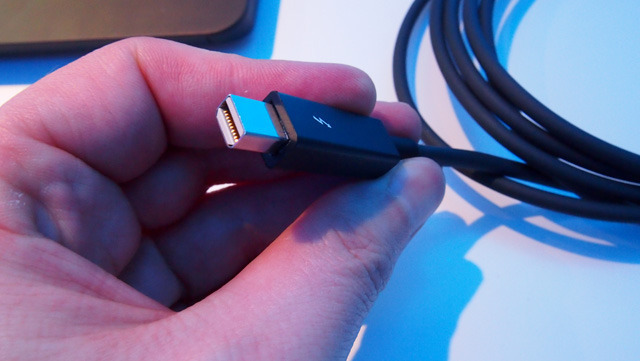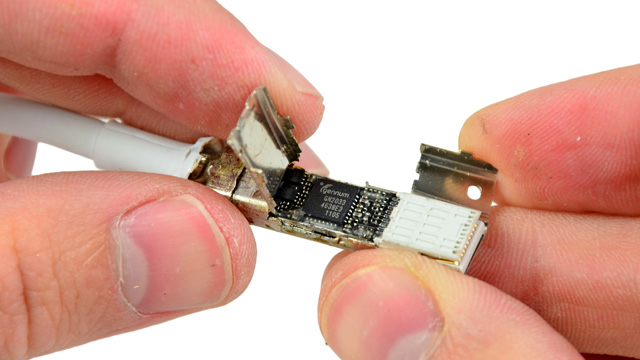
Intel's Thunderbolt high-speed interconnect has been shipping for over a year now, and new vendors have been announcing products compatible with the standard ever since. One sticking point, however, has been that Thunderbolt devices require an expensive $50 cable—only available from Apple until recently. And unfortunately, prices aren't coming down any time soon.
While other vendors are now offering their own Thunderbolt cables, prices have mostly stayed the same—in fact, some have gone up. We found this surprising; typically more vendors offering competing products leads to lower prices. And as the high cable price represents a fairly high barrier to entry for Thunderbolt devices, it relegates the standard to niche, early-adopter territory.
This isn't likely to change in the near future. Our research shows that for the rest of 2012, Thunderbolt cables are going to remain in the $45-60 price range. Prices aren't likely to drop noticeably until early 2013, when second-generation silicon for Thunderbolt's active cabling becomes available in production quantities.
The current landscape
Belkin, Elgato, and Kanex are some of the latest vendors offering Thunderbolt cables to work with a growing number of drives, docks, and other devices coming to market. But in many cases, the cables are more expensive than Apple's $50 cable. Kanex offers its own 2m cable for $60. Elgato, which recently released a portable Thunderbolt SSD, sells a 0.5m cable to go along with it, also $60. The only "cheaper" cable out there is a 1m branded one Belkin offers to go along with its upcoming Thunderbolt Express Dock for $45.
Besides Apple, the only volume supplier of Thunderbolt cables currently seems to be Japanese electrical cable manufacturer Sumitomo. Intel has been using the distinctive black version of the cables in demonstrations throughout the year, including at CES and Computex. We found Sumitomo's cables available from Amazon Japan in sizes from 0.3m to 3m, for the equivalent of $48-$62. Its 2m cable, available in white or black, costs $56 (plus shipping from Japan).
A Sumitomo representative told Ars that the company has no plans to retail its cables in the US; instead, it is partnering with local vendors to brand and distribute the cables. The Elgato and Belkin cables appear to be made by Sumitomo, though neither company would confirm that to us. Kanex's cable appears to be manufactured by another OEM.
Change in motion
All these cables have one thing in common, according to John Mitchell, marketing manager for signal processing chip maker Intersil. "All of them are based on the Gennum transceiver, what we call first-gen cable," Mitchell explained. That transceiver—now manufactured by Semtech, which acquired Gennum in March—is the same one used in Apple's cable.

The chip is built using silicon germanium, "an expensive semiconductor process typically used for telecom applications," Mitchell told Ars. It's likely that Intel and Apple chose the Semtech part because it was either an already existing part that fit the requirements for Thunderbolt's high 10Gbps bi-directional data rate, or Semtech had something similar that was easily adaptable.
In addition to the transceiver, the current reference design also requires a separate microcontroller, as well as power management and voltage regulation chips to deliver the 3V data signals and 15V optional power supply for bus-powered devices. Essentially, there are four integrated circuits (IC) at either end of a Thunderbolt cable.
"Active cables need clock and data recovery chips on either end, even for optical cables," Mitchell said. "This makes Thunderbolt very robust—signal is cleaned up by the cable, even if a device is 'noisy.'"
Combined with relatively high-quality copper cable, Thunderbolt quickly becomes rather expensive equipment. For comparison, passive cables (such as those used for HDMI or USB) cost under $10 for a 2m cable.
But Mitchell said that his company has a solution to the problem currently in the pipeline and set to ship in volume in the latter part of this year. What Intersil calls an "Active Cable IC Solution for Thunderbolt Technology" appears to be the only complete turnkey solution we could find among manufacturers selling ICs for Thunderbolt. It combines the microcontroller and transceiver into a single signal processing chip, and combines power management and voltage regulators into a single power management chip. This cuts the number of required ICs from four to two.

The chips are manufactured on a lower cost, 40nm CMOS process, improving yields and lowering costs significantly. The 40nm process also dissipates less heat, reducing the need for bulky heat sinking within the cable plug.
The chipset also uses Intersil's patented "cable compensation" techniques, which account for signal skew and dispersion within the copper conductors. "We've been designing around these problems for data center applications, by using advanced equalization and cable impairment correction," Mitchell said. Bringing the technology to Thunderbolt will allow cable manufacturers to use a lower-grade cable while still maintaining 10Gbps throughput.
In addition to these improvements, Intersil's chipset includes features like integrated error-rate testers and switching loopbacks, all designed to aid in automated testing. "These features help cable assemblers test the cables during the manufacturing process, streamlining the workflow," Mitchell said.
"Our solution is half the chips, half the size, uses half the power, and cheaper conductors can be used. By the end of the year, cables will be less expensive."
That news bodes well for the Thunderbolt ecosystem, which will begin expanding this year as a new wave of Thunderbolt-equipped Macs and PCs work their way into consumers' hands. "It's pretty much been an Apple thing with a few drives," Mitchell told Ars of the current landscape. "But with Ivy Bridge and Intel's new Thunderbolt controllers, the rest of this year is going be very interesting."
reader comments
138